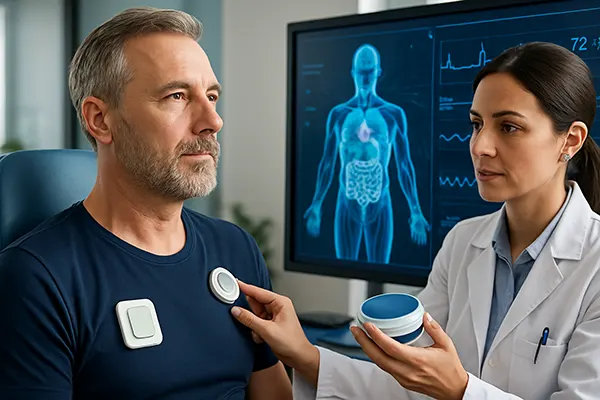
Digital Health 2.0: Implants, Sensors and AI-Driven Personalised Medicine
The rapid evolution of medical technology by 2025 has transformed the way individuals monitor their health, interact with clinicians and manage long-term conditions. Digital Health 2.0 represents a shift towards integrated biomedical systems where implants, smart sensors and artificial intelligence produce precise, real-time data that supports more accurate diagnoses and treatment decisions. This approach strengthens patient autonomy, improves clinical outcomes and creates a continuous flow of medically relevant information that was not possible a decade ago.
Implantable Technologies and Their Clinical Role
Modern implantable devices have moved far beyond traditional pacemakers and orthopaedic solutions. By 2025, smart implants equipped with micro-sensors can measure biochemical markers, adjust therapeutic doses and wirelessly communicate with clinical dashboards. These systems help physicians personalise treatment protocols, particularly in cardiology, endocrinology and neurology.
One of the most notable developments is closed-loop implants for diabetes care. These devices track glucose levels continuously and deliver insulin with precision, reducing fluctuations and lowering the risk of complications. Advances in materials science, especially biocompatible polymers and graphene-based components, have also increased the longevity and safety of such implants.
Implants are increasingly used for pain management, epilepsy control and mobility restoration. Neural implants capable of stimulating specific brain regions are showing positive outcomes for patients with treatment-resistant depression and Parkinson’s disease. Their interaction with AI algorithms brings a level of accuracy that manual adjustments cannot match.
AI Integration in Implant Functionality
AI gives implantable devices the ability to interpret continuous data streams and adapt in real time. By processing patterns that clinicians may not identify immediately, algorithms improve the reliability of implant-based therapies. Machine learning models used in cardiac monitors can anticipate arrhythmias minutes before they occur, allowing timely intervention.
Recent regulatory standards require AI-enabled implants to undergo rigorous validation to ensure accuracy and minimise false readings. These frameworks provide the level of safety assurance needed for patient-critical environments. As datasets grow, the performance of predictive models improves without requiring physical upgrades to the implant itself.
AI-driven implants also support remote monitoring, enabling patients to remain at home while specialists review updates via secure clinical systems. This reduces hospital visits, improves the quality of long-term care and facilitates earlier responses to health deterioration.
Wearable Sensors and Continuous Health Tracking
Wearable sensors have become essential tools for physiological monitoring. Devices available in 2025 track heart rate variability, blood oxygen levels, blood pressure, sleep phases and even hydration. Their increased accuracy is the result of improved optical sensors, multispectral data capture and recalibrated AI models trained on larger clinical datasets.
Continuous monitoring has become particularly relevant for individuals with cardiovascular disease, respiratory conditions and autoimmune disorders. Data from sensors allow clinicians to adjust medication doses and treatment plans with better precision. Many healthcare systems now integrate sensor outputs into electronic health records, providing clinicians with a richer understanding of patient conditions.
Sports medicine also benefits from these technologies. Athletes and physiotherapists use sensor-based analytics to prevent injuries, monitor recovery and optimise training cycles. Insights generated from real-time data have proven more accurate than self-reported symptoms or periodic clinical tests.
Sensor-Generated Data and Healthcare Decision-Making
Reliable decision-making requires high-quality data, and wearable sensors now meet medical-grade standards in several categories. AI models filter noise, detect anomalies and convert raw values into clinically meaningful insights. This makes sensor-generated data more actionable for medical professionals.
Clinicians increasingly rely on automated trend analysis to detect early signs of deterioration. For example, declining oxygen saturation patterns can indicate respiratory issues days before symptoms appear. Early alerts lead to timely medical intervention and reduce hospitalisation risk.
Sensor integration also supports personalised wellness plans. AI correlates lifestyle patterns with physiological responses, helping users adjust sleep habits, activity levels and stress-management routines. As privacy regulations strengthen, users maintain more control over how their data is stored and shared.

AI-Driven Personalised Medicine
Personalised medicine uses individual biological, behavioural and environmental data to tailor treatment. By 2025, AI systems analyse genomic information, wearable sensor data and clinical histories to provide treatment recommendations that match a patient’s unique profile. This approach is widely used in oncology, cardiology and metabolic health.
In oncology, algorithms support the identification of treatment combinations with the highest probability of success for specific tumour mutations. Pharmacogenomic data also helps predict how patients respond to certain medications, reducing the risk of adverse effects and improving therapy efficacy.
The combination of AI with genomics allows clinicians to adopt preventive strategies. Predictive models identify genetic predispositions and guide early interventions, lifestyle planning and targeted screenings. This reduces long-term treatment costs and contributes to earlier detection of chronic illnesses.
Future Directions in Personalised AI Medicine
The next phase of personalised medicine focuses on creating unified patient profiles that integrate genomic data, behavioural metrics and real-time sensor readings. This fusion enables more holistic care models that better reflect the complexities of human health. AI simplifies the interpretation of this vast information, allowing specialists to focus on decision-making rather than data processing.
Advanced clinical simulations powered by AI help doctors forecast treatment outcomes for various scenarios. This capability supports discussions between clinicians and patients, providing clearer expectations and helping individuals understand potential risks and benefits.
Long-term development aims to enhance cross-border healthcare collaboration. Secure data-sharing frameworks ensure that medical specialists in different regions can access relevant patient details when necessary. This approach is particularly important for rare conditions, where expertise may be limited to specific research centres.



